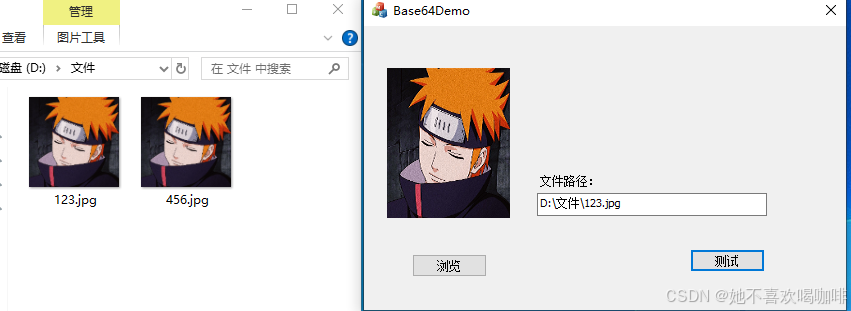1 ++Base64.h
cpp
//++Base64.h
#pragma once
#include <string>
using namespace std;
class CBase64
{
public:
public:
CBase64();
~CBase64();
/*编码
DataByte
[in]输入的数据长度,以字节为单位
*/
std::string Encode(const char* Data, int DataByte);
/*解码
DataByte
[in]输入的数据长度,以字节为单位
OutByte
[out]输出的数据长度,以字节为单位,请不要通过返回值计算
输出数据的长度
*/
std::string Decode(const char* Data, int DataByte, int& OutByte);
};
cpp
//++Base64.cpp
#include "stdafx.h"
#include "++Base64.h"
CBase64::CBase64()
{
}
CBase64::~CBase64()
{
}
std::string CBase64::Encode(const char* Data, int DataByte)
{
//编码表
const char EncodeTable[] = "ABCDEFGHIJKLMNOPQRSTUVWXYZabcdefghijklmnopqrstuvwxyz0123456789+/";
//返回值
string strEncode;
unsigned char Tmp[4] = { 0 };
int LineLength = 0;
for (int i = 0; i<(int)(DataByte / 3); i++)
{
Tmp[1] = *Data++;
Tmp[2] = *Data++;
Tmp[3] = *Data++;
strEncode += EncodeTable[Tmp[1] >> 2];
strEncode += EncodeTable[((Tmp[1] << 4) | (Tmp[2] >> 4)) & 0x3F];
strEncode += EncodeTable[((Tmp[2] << 2) | (Tmp[3] >> 6)) & 0x3F];
strEncode += EncodeTable[Tmp[3] & 0x3F];
if (LineLength += 4, LineLength == 76) { strEncode += "\r\n"; LineLength = 0; }
}
//对剩余数据进行编码
int Mod = DataByte % 3;
if (Mod == 1)
{
Tmp[1] = *Data++;
strEncode += EncodeTable[(Tmp[1] & 0xFC) >> 2];
strEncode += EncodeTable[((Tmp[1] & 0x03) << 4)];
strEncode += "==";
}
else if (Mod == 2)
{
Tmp[1] = *Data++;
Tmp[2] = *Data++;
strEncode += EncodeTable[(Tmp[1] & 0xFC) >> 2];
strEncode += EncodeTable[((Tmp[1] & 0x03) << 4) | ((Tmp[2] & 0xF0) >> 4)];
strEncode += EncodeTable[((Tmp[2] & 0x0F) << 2)];
strEncode += "=";
}
return strEncode;
}
std::string CBase64::Decode(const char* Data, int DataByte, int& OutByte)
{
//解码表
const char DecodeTable[] =
{
0, 0, 0, 0, 0, 0, 0, 0, 0, 0, 0, 0, 0, 0, 0, 0, 0, 0, 0, 0, 0, 0, 0, 0,
0, 0, 0, 0, 0, 0, 0, 0, 0, 0, 0, 0, 0, 0, 0, 0, 0, 0, 0,
62, // '+'
0, 0, 0,
63, // '/'
52, 53, 54, 55, 56, 57, 58, 59, 60, 61, // '0'-'9'
0, 0, 0, 0, 0, 0, 0,
0, 1, 2, 3, 4, 5, 6, 7, 8, 9, 10, 11, 12,
13, 14, 15, 16, 17, 18, 19, 20, 21, 22, 23, 24, 25, // 'A'-'Z'
0, 0, 0, 0, 0, 0,
26, 27, 28, 29, 30, 31, 32, 33, 34, 35, 36, 37, 38,
39, 40, 41, 42, 43, 44, 45, 46, 47, 48, 49, 50, 51, // 'a'-'z'
};
//返回值
string strDecode;
int nValue;
int i = 0;
while (i < DataByte)
{
if (*Data != '\r' && *Data != '\n')
{
nValue = DecodeTable[*Data++] << 18;
nValue += DecodeTable[*Data++] << 12;
strDecode += (nValue & 0x00FF0000) >> 16;
OutByte++;
if (*Data != '=')
{
nValue += DecodeTable[*Data++] << 6;
strDecode += (nValue & 0x0000FF00) >> 8;
OutByte++;
if (*Data != '=')
{
nValue += DecodeTable[*Data++];
strDecode += nValue & 0x000000FF;
OutByte++;
}
}
i += 4;
}
else// 回车换行,跳过
{
Data++;
i++;
}
}
return strDecode;
}3 Base64DemoDlg.cpp 中加入调用代码,Base64DemoDlg.h 中引入 ++Base64.h 头文件。
cpp
//以下是读写图片的调用代码:
bool ReadPhotoFile(std::basic_string<TCHAR> strFileName, std::string &strData)
{
HANDLE hFile;
hFile = CreateFile(strFileName.c_str(), GENERIC_READ, 0, NULL, OPEN_EXISTING, FILE_ATTRIBUTE_NORMAL, NULL);
if (hFile == INVALID_HANDLE_VALUE)
{
return false;
}
DWORD dFileSize = GetFileSize(hFile, NULL);
char * pBuffer = new char[dFileSize + 1];
if (pBuffer == NULL)
return false;
memset(pBuffer, 0, dFileSize);
DWORD dReadSize(0);
if (!ReadFile(hFile, pBuffer, dFileSize, &dReadSize, NULL))
{
delete[]pBuffer;
CloseHandle(hFile);
return false;
}
CBase64 base64;
strData = "";
strData = base64.Encode((const char*)pBuffer, dReadSize);
delete[]pBuffer;
CloseHandle(hFile);
return true;
}
bool WritePhotoFile(std::basic_string<TCHAR> strFileName, std::string &strData)
{
HANDLE hFile;
hFile = CreateFile(strFileName.c_str(), GENERIC_WRITE, 0, NULL, CREATE_ALWAYS, FILE_ATTRIBUTE_NORMAL, NULL);
if (hFile == INVALID_HANDLE_VALUE)
{
return false;
}
CBase64 base64;
int datalen(0);
DWORD dwritelen(0);
std::string strdcode = base64.Decode(strData.data(), strData.size(), datalen);
if (!WriteFile(hFile, strdcode.data(), datalen, &dwritelen, NULL))
{
CloseHandle(hFile);
return false;
}
CloseHandle(hFile);
return true;
}4 测试,获取图片路径,读取图片加密得到 imageData,然后将 imageData 解密写入新文件。
cpp
//测试
void CBase64DemoDlg::OnBnClickedButtonTest()
{
//1 获取文本框文件路径
CString strFilePath;
GetDlgItemText(IDC_EDIT_FILEPATH, strFilePath);
//2 图片文件进行 Base64编码,存储到 imageData
string imageData;
ReadPhotoFile(strFilePath.GetString(), imageData);
//3 将 imageData 解码后,生成 新图片
CString strNewFilePath;
strNewFilePath = _T("D:\\文件\\456.jpg");
WritePhotoFile(strNewFilePath.GetString(), imageData);
//其他
/*
CString 转 std::wstring
std::wstring str = filename.GetString();
std::wstring 转 CString
CString str( filename.c_str() );
*/
}5 效果

参考:
C++读写图片数据转成Base64格式的一种方法
https://www.cnblogs.com/jeray/p/8746976.html
C++读写图片数据转成Base64格式
https://www.cnblogs.com/chechen/p/10417424.html
CString和wstring互转